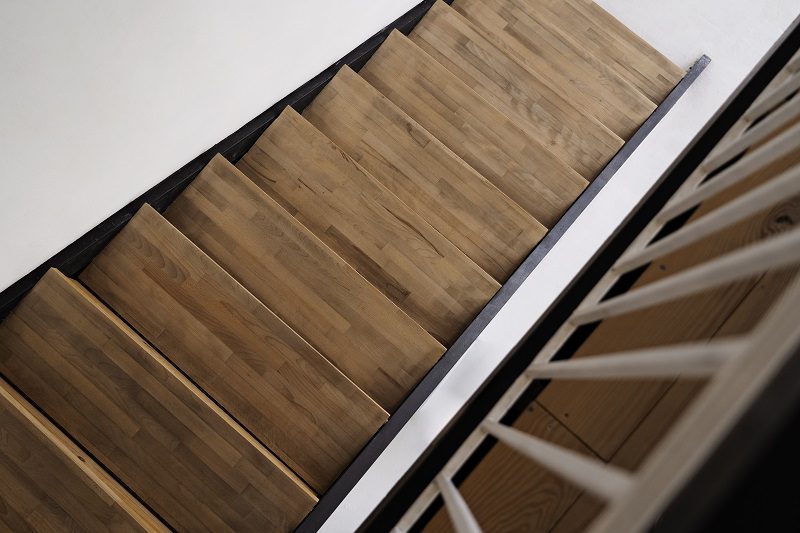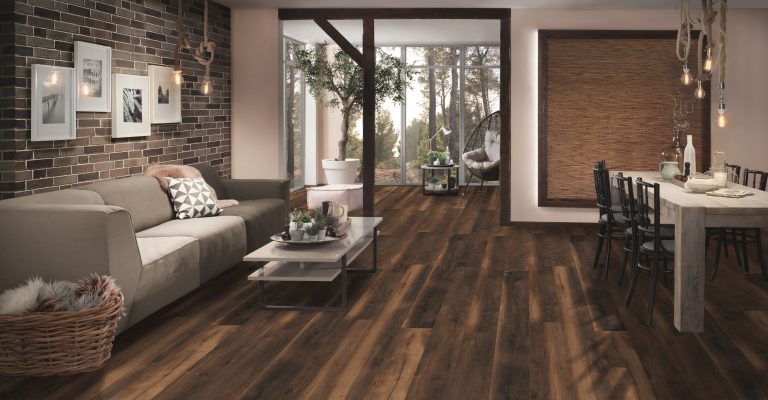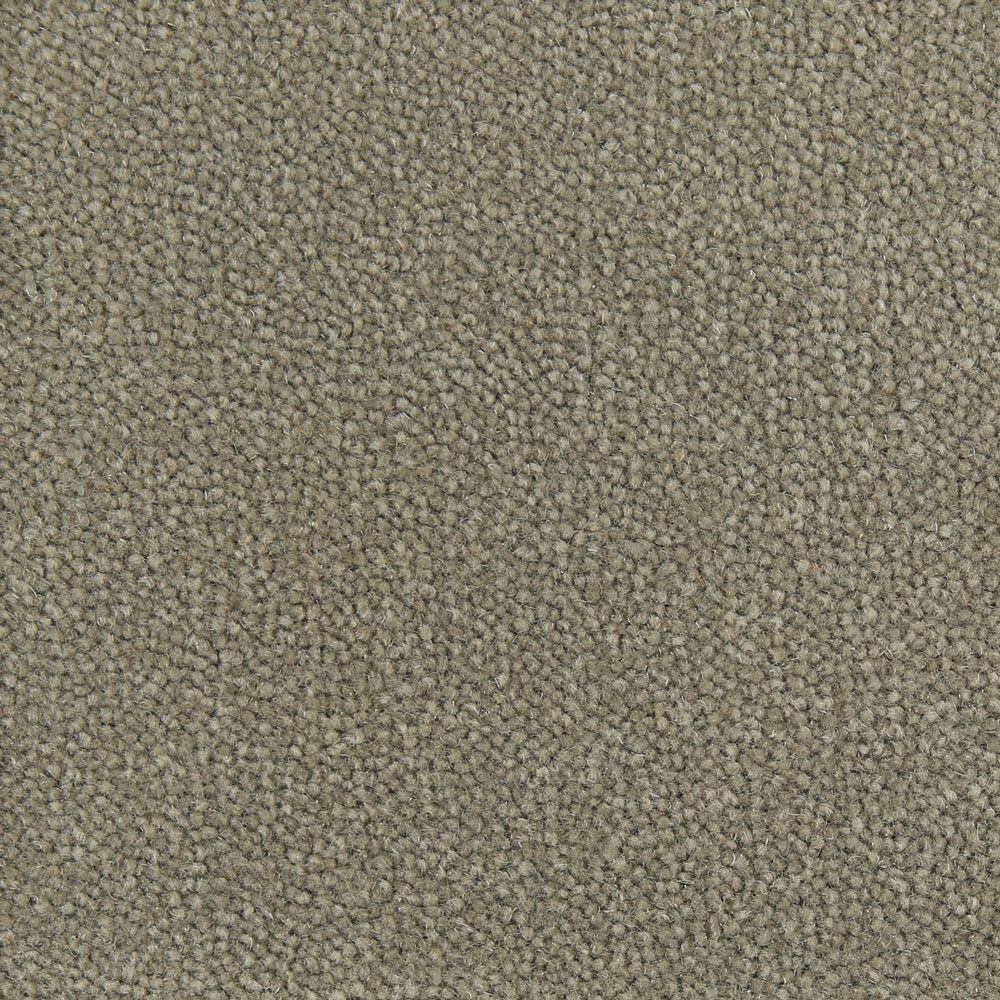Laminate flooring is a popular and versatile option for homeowners, offering a durable and cost-effective alternative to traditional hardwood. Therefore, laminate flooring is among the best stairs flooring ideas that you can use to enhance the look of your home. In this article, we will explore the different types of laminate flooring, why it is suitable for stairs, and the factors to consider when choosing the best laminate flooring for stairs. We will also discuss installation tips and techniques to ensure a successful and stylish result. Whether you’re renovating or building from scratch, this guide will help you choose the best laminate flooring for stairs that’s right for your home.
Key Points:
Laminate flooring is a synthetic material that mimics the appearance of hardwood or stone. So, if you’re wondering can you cover stairs with laminate flooring? Of course you can. In fact, laminate flooring is ideal for stairs because of its durability, slip resistance, and cost-effectiveness compared to other flooring options. When choosing laminate flooring for stairs, consider factors such as durability, slip resistance, thickness, stair nosing, and budget.
What Is Laminate Flooring?
Laminate flooring is a type of flooring that consists of multiple layers of synthetic materials fused together. It is designed to mimic the look of natural materials such as wood or stone and is often used as a cost-effective alternative to these materials. Laminate flooring is popular for its durability, easy maintenance, and versatility in design options.
Laminate flooring refers to a synthetic floor covering product designed to simulate the appearance of natural materials, such as wood or stone, whilst offering enhanced durability and ease of maintenance.
Its construction typically consists of four layers: a wear layer, a design layer, a core layer, and a backing layer.
The wear layer provides resilience against scratches and dents, whilst the design layer showcases high-definition images of natural materials, meticulously replicating their visual texture and grain patterns.
The core layer is often made of high-density fibreboard or compressed wood, providing stability and resistance to moisture, whilst the backing layer adds further structural strength and stability.
This unique composition makes laminate flooring exceptionally well-suited for areas prone to high foot traffic, such as living rooms, kitchens, and hallways, as it offers both visual appeal and durability.
Why Is Laminate Flooring Suitable for Stairs?
Laminate flooring is a suitable option for stairs for several reasons. It is durable, easy to clean, and comes in a variety of designs to match the aesthetic of your home. Additionally, laminate flooring is generally more affordable than other options, making it a practical choice for staircases.
Laminate flooring presents a suitable option for stairs due to its robust construction, aesthetic versatility, and adaptability to varying staircase designs and configurations.
The durability of laminate flooring ensures it can withstand the heavy foot traffic that stairs often experience, resisting wear and tear admirably.
Its visual appeal is enhanced through a wide range of patterns, colours, and textures, allowing homeowners to achieve the desired aesthetic for their staircases.
Laminate can be easily cleaned and maintained, making it a practical choice for areas prone to dirt and debris accumulation.
Its compatibility with different staircase structures and materials enables seamless integration, providing a cohesive look to the overall space.
The Different Types of Laminate Flooring
In determining the best laminate flooring for stairs, of course you need to know what types of laminate flooring are available. Various types of laminate flooring are available on the market, including High-Pressure Laminate (HPL), Direct Pressure Laminate (DPL), and Laminate with Attached Underlay, each offering distinct features and installation advantages.
HPL laminate flooring is renowned for its exceptional durability and resistance to wear, making it a popular choice for high-traffic areas. On the other hand, DPL offers affordability and ease of installation, ideal for budget-conscious consumers.
Laminate with attached underlay streamlines the installation process, providing enhanced comfort and sound insulation. When considering laminate flooring options, it’s important to assess the specific requirements of the space.
HPL stands out for its ability to withstand heavy impacts, making it suitable for commercial settings. DPL serves as an excellent choice for residential applications, combining cost-effectiveness with enduring performance.
Laminate with attached underlay offers added cushioning and noise reduction, making it perfect for areas where a quieter environment is desired, such as bedrooms and living rooms. With these diverse options, consumers can find the perfect laminate flooring to meet their unique needs.
a. High-Pressure Laminate (HPL)
High-pressure laminate (HPL) is a premium category of laminate flooring known for its exceptional durability, impact resistance, and superior dimensional stability. This makes it a preferred choice for high-traffic areas and commercial applications.
HPL is manufactured by fusing multiple layers of materials under high heat and pressure. These materials include kraft paper, decorative paper, and resin. The core is typically made of layers of phenolic resin-impregnated kraft paper, providing strength and stability.
The top surface is embellished with a decorative paper saturated in melamine resin. This adds resilience and makes it resistant to scratches, impacts, and wear. As a result, HPL is able to maintain its appearance and performance in demanding environments.
Due to its formidable attributes, HPL finds extensive use in settings where durability and longevity are critical. This includes high-traffic areas like retail spaces, restaurants, airports, and educational institutions. It also excels in residential settings, particularly in kitchens, bathrooms, and living areas. Its strength and resistance to moisture and abrasion are highly beneficial in these areas.
b. Direct Pressure Laminate (DPL)
Direct Pressure Laminate (DPL) represents a versatile category of laminate flooring valued for its cost-effectiveness, ease of installation, and diverse design options, catering to a broad spectrum of residential and light commercial applications.
Manufactured using high pressure and heat, DPL is constructed with a chipboard core, providing stability and durability, and ensuring resistance to moisture and wear.
Its low-maintenance nature makes it a popular choice for busy households and commercial spaces. DPL’s customisation capabilities allow for realistic wood, stone, and tile visuals, offering a wide array of designs to suit various interior styles.
Its affordability and straightforward installation process make DPL an appealing choice for those seeking both functionality and style.
c. Laminate with Attached Underlayment
Laminate flooring with attached underlay offers enhanced sound absorption, moisture protection, and installation convenience, streamlining the process of laying the flooring material while providing added comfort and acoustical benefits.
With the integrated underlay, homeowners and installers save time and effort during installation, as there’s no need for separate underlay materials. This not only reduces the overall cost but also simplifies the entire process.
The attached underlay enhances the flooring’s resistance to moisture, making it an ideal choice for areas prone to dampness or humidity. The sound-absorbing properties of the underlay create a quieter and more peaceful environment, especially in multi-storey buildings or high-traffic areas.
Factors to Consider when Selecting the Best Laminate Flooring for Stairs
Several critical factors should be evaluated when selecting the best laminate flooring for stairs, including durability, slip resistance, thickness, stair-nosing options, and budget considerations, to ensure optimal performance and aesthetic cohesion.
Choosing best laminate flooring for stairs involves several crucial considerations. The durability of the laminate is paramount as stairs are high-traffic areas. It’s essential to select a laminate that can withstand constant use without showing signs of wear and tear.
Additionally, slip resistance is vital to ensure safety, especially on steps. Opting for a laminate with a textured surface or an added grip layer can significantly reduce the risk of slipping.
The thickness of the laminate is also significant. Thicker laminates often offer better stability and durability, making them a suitable choice for stairs. They can withstand the impact of heavy foot traffic and everyday use, contributing to the longevity of the flooring.
In terms of stair nosing, it’s important to consider the available solutions that offer a seamless transition between the laminate flooring and the stairs. Properly installed stair nosing not only enhances the appearance of the stairs but also provides a smooth and secure edge.
Of course, budget considerations play a crucial role in decision-making. It’s vital to find a balance between quality and cost-effectiveness, ensuring that the chosen laminate flooring meets both aesthetic and practical needs. By carefully weighing these factors, one can make an informed decision that contributes to the overall safety, durability, and visual appeal of the staircase.
a. Durability
Durability is a pivotal aspect to assess when selecting laminate flooring for stairs, ensuring longevity, wear resistance, and sustained performance under frequent foot traffic and environmental stressors.
When considering laminate flooring for stairs, its ability to withstand daily use, impacts, and environmental factors is crucial.
The construction of laminate flooring for stairs involves layers of material that are fused together under high pressure, creating a durable surface. Protective features such as scratch-resistant coatings and impact-resistant cores further enhance its ability to maintain its appearance and structural integrity over time.
b. Slip Resistance
Slip resistance is a crucial consideration for laminate flooring used on stairs, influencing safety, traction, and the prevention of potential slips and falls, especially in households with elderly individuals or young children.
Ensuring slip resistance in laminate flooring for stairs is paramount for maintaining safety and instilling confidence in users during stair traversal. With the potential for high foot traffic and various environmental conditions, the slip resistance of the laminate surface plays a crucial role in providing stability and reducing the risk of accidents.
Factors such as surface texture, protective coatings, and the overall composition of the laminate material significantly contribute to its slip-resistant properties. The presence of textured finishes, embossed surfaces, and anti-slip mechanisms enhances the grip and traction, adding an extra layer of security for individuals navigating the stairs.
c. Thickness
Selecting the appropriate thickness of laminate flooring for stairs is crucial, as it impacts structural stability, noise reduction, and the compatibility of the flooring material with stair-nosing profiles and installation requirements.
The thickness of laminate flooring plays a vital role in ensuring the structural support required for stair installations. A thicker laminate flooring can provide enhanced stability and durability, especially in high-traffic areas such as stairs.
A thicker flooring material contributes to effective sound attenuation, minimising the noise associated with foot traffic on stairs, thereby creating a quieter and more comfortable environment.
The thickness of the laminate is closely linked to its compatibility with stair-nosing solutions. Opting for an appropriate thickness ensures that the laminate flooring seamlessly integrates with various stair-nosing profiles, enhancing the overall aesthetic appeal and safety of the stair installation.
Whether it’s flush mount or overlap stair nosing, the right laminate thickness is essential for a seamless transition and a secure finish.
d. Stair Nosing
Stair-nosing options play a vital role in the successful installation of laminate flooring on stairs, providing visual continuity, edge protection, and a finished appearance while addressing safety and structural considerations.
Choosing the right stair-nosing profiles can greatly enhance the aesthetic appeal of the staircase while ensuring a smooth transition from one step to another.
The installation of nosing adds durability and support to the laminate flooring, preventing wear and tear on the edges. From a safety perspective, the nosing creates a visibly defined edge, reducing the risk of slips and falls. The selection of different nose styles, such as bullnose, flush, or overlap, determines the overall look and functionality of the staircase.
e. Budget
Considering the budgetary aspects of selecting laminate flooring for stairs is essential, as it enables homeowners to align their preferences with cost-effective options that fulfil both aesthetic and performance requirements within specified financial parameters.
When considering options for cost-effective laminate flooring on stairs, it’s important to find a balance between cost, quality, and design preferences. This can be achieved by exploring different flooring materials, installation methods, and maintenance requirements to identify value-driven solutions that fit the budget and offer long-term benefits.
Proper financial planning is also crucial in ensuring the successful completion of stair flooring projects while meeting desired design and performance standards.
How to Install Laminate Flooring on Stairs?
Installing laminate flooring on stairs involves a systematic process that includes precise measurements, preparation of the staircase, application of adhesive materials, and the secure installation of individual laminate planks to achieve a professional and durable finish.
Accurate measurements of the staircase dimensions are crucial to ensure the proper fit of the laminate planks.
After measuring, it’s vital to prepare the stairs by cleaning the surface thoroughly and removing any existing flooring or carpet.
Next, applying the appropriate adhesive materials evenly on each stair is essential to create a strong bond between the stairs and the laminate planks.
In terms of installing the individual laminate planks, using a high-quality underlay is recommended to minimise noise and provide a comfortable feel underfoot.
Having the right tools such as a saw, spacers, tapping block, and a quality laminate flooring installation kit can significantly streamline the installation process and ensure precision.
There you have it, a complete guide to choosing the best laminate flooring for stairs. As explained above, for a great result, the selection of the best laminate flooring for stairs must also be followed by the right installation process.
In this case, you don’t need to worry because there are carpet and flooring fitting services from TEKA Flooring that can help you in installing laminate flooring for stairs.
With professional and certified experts, TEKA Flooring team will provide all your flooring needs, whether for residential, commercial, or specialised projects such as hospital grade flooring installation.
So, you have nothing to worry about as TEKA Flooring team will guide you in terms of design, technical requirements, and measurement. Call us today to get a FREE quote on 01733 731 930.
Read also: Best Carpet For Stairs And Landing Ideas For 2024

































